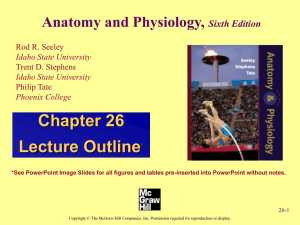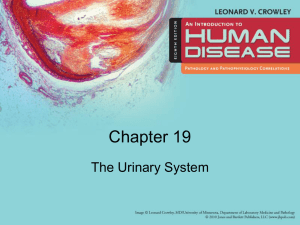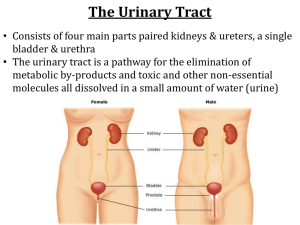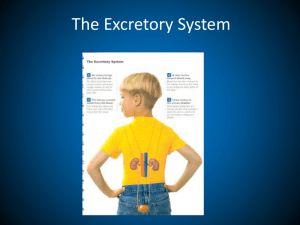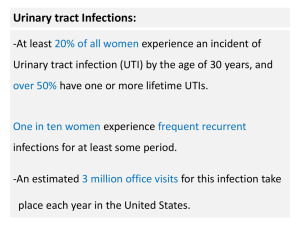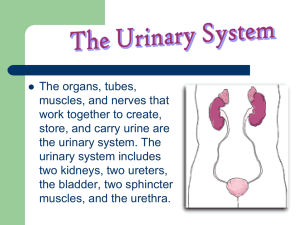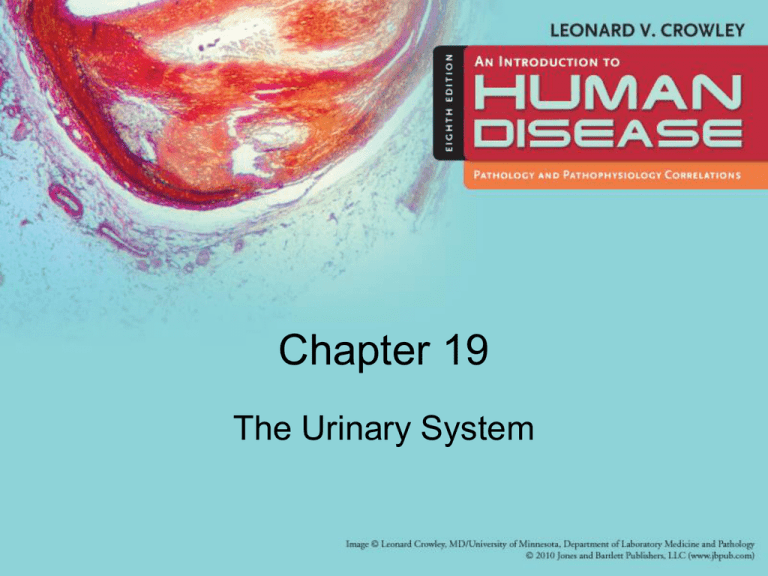
Chapter 19
The Urinary System
Learning Objectives (1 of 2)
• Describe normal structure and functions of
the kidneys
• Explain pathogenesis and clinical
manifestations of glomerulonephritis,
nephrosis, nephrosclerosis, and
glomerulosclerosis
• Describe clinical manifestations and
complications of urinary tract infections
• Describe causes of renal tubular injury,
manifestations, treatment
Learning Objectives (2 of 2)
• Explain mechanism of urinary tract calculi
formation, complications, manifestations of
urinary tract obstruction
• Differentiate major forms of cystic disease of
the kidney and prognoses; common tumors
affecting urinary tract
• Describe causes, clinical manifestations,
treatment of renal failure
• Describe principles and techniques of
hemodialysis
Urinary System
• Kidneys: produce urine
• Excretory duct system
–
–
–
–
Ureter: conveys urine into bladder by peristalsis
Renal pelvis: expanded upper portion of ureter
Major calyces: subdivisions of renal pelvis
Minor calyces: subdivisions of major calyces into which
renal papillae discharge
• Bladder: stores urine
– Discharges urine into urethra during voiding
– Anatomic configuration of bladder and ureters normally
prevents reflux of urine into ureters
• Urethra: conveys urine from the bladder for
excretion
Components Urinary System
Urinary System Organs
Figure 25.1a
Kidneys (1 of 2)
• Paired, bean-shaped organs below diaphragm
adjacent to vertebral column
• Divided into outer cortex and inner medulla (renal
pyramids and columns)
• Excretory organs, functions along with lungs in
excreting waste products of food metabolism
• Three basic functions
– 1. Excrete waste products of food metabolism
• CO2 and H2O: end-products of carbohydrate and fat metabolism
• Urea and other acids: end-products of protein metabolism that
only the kidneys can excrete
Kidneys (2 of 2)
– 2. Regulate mineral and H2O balance
• Excretes excess minerals and H20 ingested and
conserving them as required
• Body’s internal environment is determined not by
what a person ingests but by what the kidneys retain
– 3. Produces erythropoietin and renin:
specialized cells in the kidneys
• Erythropoietin: regulates RBC production in marrow
• Renin: helps regulate blood pressure
Nephron (1 of 2)
•
•
•
•
Basic structural and functional unit of the kidney
About 1 million nephrons in each kidney
Consists of glomerulus and renal tubule
Glomerulus
– Tuft of capillaries supplied by an afferent glomerular
arteriole that recombine into an efferent glomerular
– Material is filtered by a 3-layered glomerular filter
• Inner: fenestrated capillary endothelium
• Middle: basement membrane
• Outer: capillary endothelial cells (with foot processes and filtration
slits)
– Mesangial cells: contractile phagocytic cells that hold the
capillary tuft together; regulate caliber of capillaries
affecting filtration rate
Nephron (2 of 2)
• Renal tubule: reabsorbs most of filtrate;
secretes unwanted components into tubular
fluid; regulates H2O balance
– Proximal end: Bowman’s capsule
– Distal end: empties into collecting tubules
• Requirements for normal renal function
– Free flow of blood through the glomerular
capillaries
– Normally functioning glomerular filter that
restricts passage of blood cells and protein
– Normal outflow of urine
A representation of fine structure of glomerular
filter as visualized by electron microscopy.
Segment of glomerular capillaries
A representation of fine structure of glomerular
filter as visualized by electron microscopy.
Cross-section through the center of the
glomerulus.
The structure of the renal tubule, illustrating its
relationship to the glomerulus and the collecting tubule.
Bowman’s Capsule
© Courtesy of Leonard Crowley, M.D./University of Minnesota Medical School
Renal Regulation of Blood Pressure
• Renin: released in response to decreased blood
volume, low blood pressure, low sodium
• Angiotensin I → angiotensin II by angiotensin
converting enzyme (ACE) as blood flows through
the lungs
• Angiotensin II:
– Powerful vasoconstrictor: raises blood pressure by
causing peripheral arterioles to constrict
– Stimulates aldosterone secretion from adrenal cortex:
increases reabsorption of NaCl and H2O by kidneys
– Net effect: higher blood pressure, increased fluid in
vascular system
• System is self-regulating
The role of the kidneys in regulation of blood
pressure and blood volume.
Developmental Abnormalities
• Developmental process is disturbed
• Normal development
– Kidneys arise from mesoderm, develop in
pelvis, ascend to final position
– Bladder derived from lower end of intestinal
tract
– Excretory ducts (ureters, calyces, pelves)
develop from ureteric buds that extend from
bladder into the developing kidneys
Developmental Aspects
Figure 21.21a, b
Developmental Aspects
Figure 25.21c, d
Three congenital abnormalities results
• Renal agenesis: failure of one or both kidneys to
develop
– Bilateral: rare, associated with other congenital
anomalies, incompatible with life
– Unilateral: common, asymptomatic; other kidney
enlarges to compensate
• Duplications of urinary tract
– Complete duplication: formation of extra ureter and renal
pelvis
– Incomplete duplication: only upper part of excretory
system is duplicated
• Malposition: one or both kidneys, associated with
fusion of kidneys; horseshoe kidney; fusion of
upper pole
Common congenital abnormalities of kidneys
and urinary tract
Glomerulonephritis
• Inflammation of the glomeruli caused by antigenantibody reaction within the glomeruli
• Immune-complex glomerulonephritis
– Usually follows a beta-streptococcal infection
– Circulating antigen and antibody complexes are filtered
by glomeruli and incite inflammation
– Leukocytes release lysosomal enzymes that cause injury
to the glomeruli
– Occurs in SLE; immune complexes trapped in glomeruli
– Occurs in IgA nephropathy
• Anti-glomerular basement membrane (anti-GBM)
glomerulonephritis: autoantibodies attack
glomerular basement membrane
• Glomerulonephritis, also known as glomerular
nephritis, is a renal disease (usually of both kidneys)
characterized by inflammation of the glomeruli, or small
blood vessels in the kidneys
• They are categorized into several different pathological
patterns, which are broadly grouped into non-proliferative
or proliferative types. Diagnosing the pattern of GN is
important because the outcome and treatment differs in
different types. Primary causes are ones which are intrinsic
to the kidney, whilst secondary causes are associated with
certain infections (bacterial, viral or parasitic pathogens),
drugs, systemic disorders (SLE, vasculitis) or diabetes.
• Non Proliferative
• This is characterized by the numbers of cells (lack of
hypercellularity) in the glomeruli. They usually cause
nephrotic syndrome. This includes the following types:
• Minimal change GN (also known as Minimal Change
Disease) causes 80% of nephrotic syndrome in children,
but only 20% in adults. As the name indicates, there are no
changes visible on simple light microscopy, but on electron
microscopy there is fusion of podocytes (supportive cells in
the glomerulus).
• Membranous glomerulonephritis a relatively common
type of glomerulonephritis in adults, frequently produces a
mixed nephrotic and nephritic picture. It's cause is usually
unknown, but may be associated with cancers of the lung
and bowel, infection such as hepatitis and malaria, drugs
including penicillamine, and connective tissue diseases
such as systemic lupus erythematosus.
• Proliferative
• This type is characterized by increased number of cells in the
glomerulus. Usually present as a nephritic syndrome and
usually progress to end-stage renal failure (ESRF) over
weeks to years (depending on type).
• IgA nephropathy (Berger's disease)
• IgA nephropathy is the most common type of
glomerulonephritis in adults worldwide. It usually presents as
macroscopic hematuria (visibly bloody urine). It occasionally
presents as a nephrotic syndrome. It often affects young
males within days (24-48hrs) after an upper respiratory tract
or gastrointestinal infection. Microscopic examination of
biopsy specimens shows increased number of mesangial
cells with increased matrix (the 'cement' which holds
everything together).
Normal glomerulus
Immune complex glomerulonephritis
Anti-GBM glomerulonephritis
Nephrotic
versus Nephritic Syndrome
• Nephritic syndrome is a collection of signs (syndrome)
associated with disorders affecting the kidneys, more
specifically glomerular disorders. It's characterized by
having small pores in the podocytes of the glomerulus, large
enough to permit proteins (proteinuria) and red blood cells
(hematuria) to pass into the urine. By contrast, nephrotic
syndrome is characterized by only proteins (proteinuria)
moving into the urine. Both nephritic syndrome and
nephrotic syndrome result in hypoalbuminemia due to
protein albumin moving from the blood to the urine.
Figure 25.7a
Figure 25.7b, c
Nephrotic Syndrome (1 of 2)
• Marked loss of protein in the urine
– Urinary excretion of protein > protein production
– Protein level in blood falls
– Causes edema due to low plasma osmotic
pressure
• Clinical manifestations
– Marked leg edema
– Ascites
Nephrotic Syndrome (2 of 2)
• Prognosis
– In children: minimal glomerular change, complete
recovery
– In adults: a manifestation of severe progressive
renal disease
• May result from
– Glomerulonephritis
– Diabetes (causing glomerular changes)
– Systemic lupus erythematosus, SLE
– Other kidney diseases
Arteriolar Nephrosclerosis
• Complication of severe hypertension
• Renal arterioles undergo thickening from carrying
blood at a much higher pressure than normal
• Glomeruli and tubules undergo secondary
degenerative changes causing narrowing of
lumen and reduction in blood flow
– Reduced glomerular filtration
– Kidneys shrink
– May die of renal insufficiency
Arteriolar thickening
Diabetic Nephropathy
Kimmelstiel-Wilson syndrome
• Complication of long-standing diabetes
• Nodular and diffuse thickening of glomerular
basement membranes (glomerulosclerosis),
usually with coexisting nephrosclerosis
• Manifestations
– Progressive impairment of renal function
– Protein loss may lead to nephrotic syndrome
– No specific treatment can arrest progression of
disease
– Progressive impairment of renal function may lead to
renal failure
Diffuse glomerulosclerosis
Nodular glomerulosclerosis
Gout Nephropathy
• Pathogenesis
– Elevated blood uric acid levels lead to ↑uric
acid in tubular filtrate
– Urate may precipitate in Henle’s loops and
collecting tubules
– Tubular obstruction causes damage
• Manifestations
– Impaired renal function
– May lead to renal failure
– Common in poorly-controlled gout
Urate nephropathy showing multiple
depressed scars
Section of kidney revealing white urate deposits within
renal pyramid and large urate deposit near tip of
pyramid
Urinary Tract Infections (1 of 2)
• Very common; maybe acute or chronic
• Most infections are caused by gram-negative
bacteria
• Organisms contaminate perianal and genital areas
and ascend urethra
• Conditions protective against infection
–
–
–
–
Free urine flow
Large urine volume
Complete bladder emptying
Acid urine: most bacteria grow poorly in an acidic
environment
Urinary Tract Infections (2 of 2)
• Predisposing factors
– Any condition that impairs free drainage of urine
– Stagnation of urine favors bacterial growth
– Injury to mucosa by kidney stone disrupts protective
epithelium allowing bacteria to invade deeper tissue
– Introduction of catheter or instruments into bladder
may carry bacteria
Cystitis
• Affects only the bladder
– More common in women than men; shorter female
urethra, and, in young sexually active women, sexual
intercourse promotes transfer of bacteria from urethra to
bladder
– Common in older men, because enlarged prostate
interferes with complete bladder emptying
• Clinical manifestations
–
–
–
–
–
Burning pain on urination
Desire to urinate frequently
Urine contains many bacteria and leukocytes
Responds well to antibiotics
May spread upward into renal pelvis and kidneys
Urethra
Figure 25.18a, b
Pyelonephritis
• Involvement of upper urinary tract from
– Ascending infection from the bladder (ascending
pyelonephritis)
– Carried to the kidneys from the bloodstream
(hematogenous pyelonephritis)
• Clinical manifestations: similar with an acute
infection
–
–
–
–
Localized pain and tenderness over affected kidney
Responds well to antibiotics
Cystitis and pyelonephritis are frequently associated
Some cases become chronic and lead to kidney failure
Vesicoureteral Reflux
• Urine normally prevented from flowing back
into the ureters during urination
• Failure of mechanisms allows bladder urine
to reflux into ureter during voiding
– Predisposes to urinary tract infection
– Predisposes to pyelonephritis
Vesicoureteral reflux
Urinary Calculi (1 of 3)
• Stones may form anywhere in the urinary tract
• Predisposing factors
– High concentration of salts in urine saturates urine
causing salts to precipitate and form calculi
• Uric acid in gout
• Calcium salts in hyperparathyroidism
– Urinary tract infections reduce solubility of salts in urine;
clusters of bacteria are sites where urinary salts may
crystallize to form stone
– Urinary tract obstruction causes urine stagnation,
promotes stasis and infection, further increasing stone
formation
Urinary Calculi (2 of 3)
• Staghorn calculus: urinary stones that increase in
size to form large branching structures that adopt
to the contour of the pelvis and calyces
• Small stones may pass through ureters causing
renal colic
• Some become impacted in the ureter and need to
be removed
• Manifestations
– Renal colic associated with passage of stone
– Obstruction of urinary tract causes hydronephrosishydroureter proximal to obstruction
Urinary Calculi (3 of 3)
• Treatment
– Cystoscopy: snares and removes stones lodged
in distal ureter
– Shock wave lithotripsy: stones lodged in
proximal ureter are broken into fragments that
are readily excreted
Cystoscopy
Large staghorn calculus of kidney
Stress Urinary Incontinence
• Involuntary loss of urine due to increases in intra-abdominal
pressure
Hypospadias
An epispadias is a rare type of
malformation of the penis in which
the urethra ends in an opening on
the upper aspect (the dorsum) of the
penis. It can also develop in females
when the urethra develops too far
anteriorly. It occurs in around 1 in
120,000 male and 1 in 500,000
female births
Urinary Obstruction
• Blockage of urine outflow leads to progressive
dilatation of urinary tract proximal to obstruction,
eventually causes compression atrophy of
kidneys
• Manifestations
– Hydroureter: dilatation of ureter
– Hydronephrosis: dilatation of pelvis and calyces
• Causes
– Bilateral: obstruction of bladder neck by enlarged
prostate or urethral stricture
– Unilateral: ureteral stricture, calculus, tumor
• Complications: stone formation; infections
• Diagnosis and treatment: pyelogram, CT scan
• Posterior urethral valves is a congenital defect in males
that results in obstruction of the bladder due to extra tissue
that projects into the urethra. This excess tissue blocks urine
from flowing freely from the bladder to the outside of the
body. This blockage, if not corrected, can cause problems in
all the organs in the urinary system including the kidneys,
ureters, urethra and bladder.
Possible locations and results of urinary tract
obstruction
Marked hydronephrosis and hydroureter
Bisected hydronephrotic kidney
Foreign Bodies in Urinary Tract
•
•
•
•
Usually inserted by patient
May injure bladder
Predispose to infection
Treatment
– Usually removed by cystoscopy
– Occasionally necessary to open bladder
surgically
X-ray film illustrating foreign body in bladder.
Renal Tubular Injury
• Pathogenesis
– Impaired renal blood flow
– Tubular necrosis caused by toxic drugs or
chemicals
• Clinical manifestation
– Acute renal failure: oliguria, anuria
– Tubular function gradually recovers
– Treated by dialysis until function returns
Renal Cysts
• Solitary cysts common; not associated with
impairment of renal function
• Multiple cysts
–
–
–
–
–
–
Congenital polycystic kidney disease
Most common cause of multiple cysts
Mendelian dominant transmission
Cysts enlarge and destroy renal tissue and function
Onset of renal failure by late middle age
Suspected by physical examination that reveals greatly
enlarged kidneys
– Some form cysts in liver or cerebral aneurysm
Renal Tumors
• Cortical tumors: arise from epithelium of renal
tubules
–
–
–
–
–
Adenomas: usually small and asymptomatic
Carcinomas more common
Hematuria often first manifestation
Invades renal vein and metastasizes into bloodstream
Treated by nephrectomy
• Transitional cell tumor: Arise from transitional
epithelium lining urinary tract
– Most arise from bladder epithelium
– Hematuria: common first manifestation
– Low grade malignancy; good prognosis
• Renal cell carcinoma (Clear Cell) is a kidney
cancer that originates in the lining of the proximal
convoluted tubule. RCC is the most common type of
kidney cancer in adults, responsible for
approximately 80% of cases. It is also known to be
the most lethal of all the genitourinary tumors. Initial
treatment is most commonly a radical or partial
nephrectomy and remains the mainstay of curative
treatment. Where the tumour is confined to the renal
parenchyma, the 5-year survival rate is 60-70%, but
this is lowered considerably where metastases have
spread. It is resistant to radiation therapy and
chemotherapy, although some cases respond to
immunotherapy.
Normal
Clear Cell Tumor
• Wilms' tumor or nephroblastoma is cancer of the
kidneys that typically occurs in children, rarely in
adults. Its common name is an eponym, referring to
Dr. Max Wilms, the German surgeon (1867–1918)
who first described this kind of tumor.
• Approximately 500 cases are diagnosed in the U.S.
annually. The majority (75%) occurs in otherwise
normal children; a minority (25%) is associated with
other developmental abnormalities. It is highly
responsive to treatment, with about 90% of patients
surviving at least five years.
Nephroblastoma (Wilms Tumor)
• Uncommon; highly malignant; affects infants
and children
• Diagnosis
– Urinalysis
– Urine culture and sensitivity tests
– Blood chemistry tests
– Clearance tests
– X-ray, ultrasound, cystoscopy
– Renal biopsy
• Treatment: nephrectomy; radiotherapy;
chemotherapy
Wilms Tumor
Renal Failure (Uremia) (1 of 2)
• Retention of excessive byproducts of protein
metabolism in the blood
• Acute renal failure
– Causes: tubular necrosis from impaired blood flow to
kidneys or effects of toxic drugs
– Renal function usually returns
• Chronic renal failure
– From progressive, chronic kidney disease; > 50% from
chronic glomerulonephritis
– Others include congenital polycystic kidney disease,
nephrosclerosis, diabetic nephropathy
Renal Failure (Uremia) (2 of 2)
• Clinical manifestations
– Weakness, loss of appetite, nausea, vomiting
– Anemia
– Toxic manifestations from retained waste
products
– Edema: retention of salt and water
– Hypertension
• Treatment
– Hemodialysis
– Hypertension
Hemodialysis
• Substitutes for the functions of the kidneys by
removing waste products from patient’s blood
• Waste products in patient’s blood diffuse across a
semipermeable membrane into a solution
(dialysate) into the other side of the membrane
• Two types
– Extracorporeal dialysis (more common): patient’s
circulation connected to an artificial kidney machine
– Peritoneal dialysis (less common): patient’s own
peritoneum is used as the dialyzing membrane
• Hemodialysis removes wastes and water by circulating blood
outside the body through an external filter, called a dialyzer,
that contains a semipermeable membrane. The blood flows
in one direction and the dialysate flows in the opposite. The
counter-current flow of the blood and dialysate maximizes the
concentration gradient of solutes between the blood and
dialysate, which helps to remove more urea and creatinine
from the blood.
• The concentrations of solutes (for example potassium,
phosphorus, and urea) are undesirably high in the blood, but
low or absent in the dialysis solution and constant
replacement of the dialysate ensures that the concentration
of undesired solutes is kept low on this side of the
membrane.
• The dialysis solution has levels of minerals like
potassium and calcium that are similar to their
natural concentration in healthy blood. For another
solute, bicarbonate, dialysis solution level is set at
a slightly higher level than in normal blood, to
encourage diffusion of bicarbonate into the blood,
to act as a pH buffer to neutralize the metabolic
acidosis that is often present in these patients
• In peritoneal dialysis, wastes and water are
removed from the blood inside the body
using the peritoneal membrane of the
peritoneum as a natural semipermeable
membrane. Wastes and excess water move
from the blood, across the peritoneal
membrane, and into a special dialysis
solution, called dialysate, in the abdominal
cavity which has a composition similar to the
fluid portion of blood.
Organ Transplants
• Four varieties
– Autografts: from one body site to another in
the same person
– Isografts: between identical twins
– Allografts: between individuals who are not
identical twins
– Xenografts: from another animal species
Renal Transplantation (1 of 2)
• Attempted when kidneys fail
• Kidney is from a close relative donor or
cadaver
• Survival of transplant depends on similarity
of HLA antigens between donor and recipient
– Only identical twins have identical HLA antigens
in their tissues; others invariably contain foreign
HLA antigens
– Consequently, patient’s immunologic defenses
will respond to the foreign antigens and attempt
to destroy (reject) foreign kidney
Renal Transplantation (2 of 3)
• Patient’s immune system must be
suppressed by drugs
Immunosuppressive drugs
• Immunosuppressive drugs can be classified into five groups:
1. Glucocorticoids – inhibit genes that code for the
interleukins s- thus they mainly inhibit cell mediated
immunity but also humoral
2. Cytostatics – inhibit cell division such as the alkylating
agents – like cyclophosphamide, platinum and others
3. Antibodies – targeted monoclonal antibodies
4. Drugs acting on immunophilins – inhibit calcineurin –
inducer of IL- 2 production
5. Other drugs
(Interferons, TNF binding proteins)
• Kidney is placed in the iliac area, outside
the peritoneal cavity
• Prognosis
– >90% of transplanted kidneys survive for 5
years when donor’s HLA antigens resemble
the patient’s
– Survival rate of cadaver transplants has
improved in recent years
Discussion
• 6-year-old boy complained of abdominal
discomfort. His mother noted that his face,
abdomen, scrotum, and legs were
edematous. His urine has large amounts of
protein and a few casts. His serum albumin
and serum protein were much lower than
normal.
– What is the boy most likely suffering from?
– Explain the generalized edema in this boy.
Discussion
• How does diabetes affect the kidneys? What
are the clinical manifestations in such case?
• What is the difference between acute and
chronic renal failure in terms of causes,
clinical manifestations, and treatment?
• What is the relationship between
glomerulonephritis and beta-streptococcal
infection?

